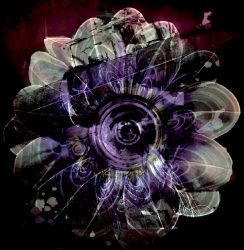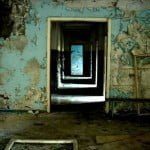“Aion” is the DVD companion to Kirkegaard’s CD release “Four Rooms” (Touch, 2006).
Inspired by Alvin Lucier’s “I am sitting in a Room” , Kirkegaard recorded the sound of deserted rooms: a church, an auditorium, a swimming pool and a gymnasium.
He then re-recorded the sound played back in the same room over and over again, multiple times, until the sound of the room became a constant drone, ultimately revealing what may be the “soul” of the room.
That is, of course, a fascinating concept in itself. But there’s another dimension to this project.
These are not just ordinary rooms, they are located in the “Zone of Alienation“, in Chernobyl, Ukraine – the zone that will remain uninhabitable for thousands of years following the 1986 nuclear accident.
Realising this, there’s an emotional layer added to the sounds that may be different for each individual user.
Is the nuclear contamination audible in any way in these recordings? Would they have sound different if recorded in any other, uncontaminated, deserted ghost town? What part of these sounds may reflect my own fears?
“Aion” , the DVD release of the “Four Rooms” project, is released exactly 25 years after the Chernobyl nuclear incident.
The visual representation of the rooms perfectly match the processed sound (which is mastered different from the CD release). Beautiful ‘stills’ of the room, changing almost unnoticeably as the outside light changes, explored by a variety of visual techniques like layers, overexposure and video feedback.
The result is as beautiful as it is scary.
“There is beauty in decay” – which was coincidentally also the introduction to my latest mix – can hardly be demonstrated more effectively than with the sound and images of this DVD.
With this underlying theme, this conceptual art project surpasses any other ambient music/field recording project that I know of.
But what possibly struck me most was the in memorian in the liner notes, dedicating this project to Rimma Kiselitsa, Kirkegaard’s Chernobyl guide.
Does this mean that she died of a nuclear overdose? Could this possibly be the first (recording) art project that someone actually died for? Is any art project worth something like that? Assuming that Rimma was a guide not only for this single project, what should we think about the nuclear zone becoming a tourist attraction, where ‘tourists’ are guided by guides that are risking their own lives?
There’s not many ambient sound art projects that I know of that raise ethical questions like this.
This is why Kirkegaard’s Four Rooms / Aion project is one of the most important sound art projects that I know of. Check this before deciding about building any new nuclear plant, please!
Available at Touchshop
Jacob Kirkegaard – Swimming Pool (CD-version from “Four Rooms”)




The room “speaks” for itself.
When I referred to the “soul” of the room, I was talking about the Jacob Kirkegaard project, not about Alvin Lucier’s Room. Kirkegaard was inspired by Lucier, but his project was quite different.
For most art, I agree with your ‘should be self-explanatory’ statement. (I mostly get tired of art where the explanation seems to be the only real art involved). However – not in all cases. Like in the case of Four Rooms, I really think there is another dimension added just by the fact of KNOWING that the drones are the sounds of the room itself, and not just the result of clever synth programming.
And there’s yet another, ungraspable, dimension added with the knowledge that the images are not just your average next-door demolition project, but are recorded from the deserted areas from polluted Chernobyl. In that case, there’s a new emotional layer added that may be different for each listener and cannot be felt the same way by any other listener. Kirkegaard has used that in other projects, like in his Labyrinthitis, where the inner ear of the listener plays an important role. Listening to this ‘as-it-is’, without knowledge of the concept behind it, may degrade the result to ‘just another drone’.
Just my opinion, of course, thanks for your comment by the way; really appreciate that!
I see your point but I wholeheartedly disagree with it. It is totally opposite to my personal creative foundation that true art should be able explain itself and not need a additional explanatory text. Actually art shouldn’t explain itself at all. It is just there and the watcher/listener deals with it one way or another. Lucier isn’t concerned with anything other than sonic phenomena. He wasn’t, in the project your refer to, working with the ‘spirit’ of the room, he let the acoustic characteristics of the room take over.